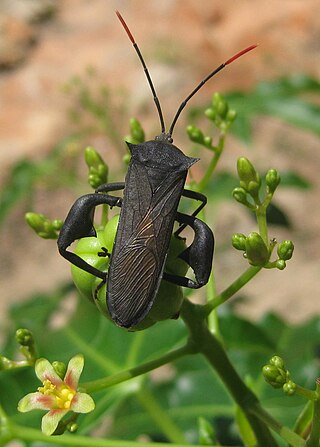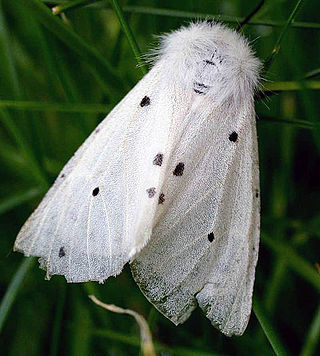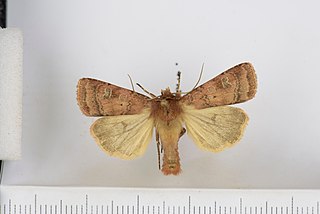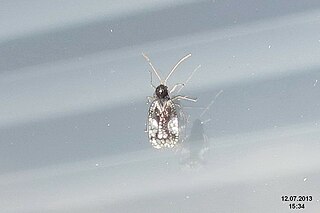
Coreidae is a large family of predominantly sap-sucking insects in the Hemipteran suborder Heteroptera. The name "Coreidae" derives from the genus Coreus, which derives from the Ancient Greek κόρις (kóris) meaning bedbug.

The ingrailed clay is a moth of the family Noctuidae. The species was first described by Johan Christian Fabricius in 1775. It is distributed through most of Europe and the Palearctic.

The small square-spot is a moth of the family Noctuidae. The species was first described by Karl Friedrich Vieweg in 1790. It is found in Europe apart from the far south-east then east through the Caucasus, Transcaucasia, Central Asia, Siberia, the Russian Far East and Kamchatka.

Flower mantises are praying mantises that use a special form of camouflage referred to as aggressive mimicry, which they not only use to attract prey, but avoid predators as well. These insects have specific colorations and behaviors that mimic flowers in their surrounding habitats.

Blepharopsis mendica is a species of praying mantis found in North Africa, parts of the Mediterranean, Middle East and southern Asia, and on the Canary Islands, and the sole member of the genus Blepharopsis. Egyptian flower mantis, thistle mantis, and Arab mantis are among its common names.

Diaphora mendica, the muslin moth, is a moth of the family Erebidae. It is found in the Palearctic realm east to Lake Baikal.

Protolampra sobrina, the cousin german, is a moth of the family Noctuidae. The species was first described by Philogène Auguste Joseph Duponchel in 1843. It is found in most of Europe, then east across the Palearctic to Siberia, Altai, Irkutsk, Kamchatka and Korea.

Diarsia florida, the fen square-spot, is a moth of the family Noctuidae. The species was first described by Schmidt in 1859. It is found from western Europe, Denmark, southern Norway and southern Sweden, east to Romania and Siberia. Subspecies perturbata is found in south-eastern Turkey.

Eubaphe mendica, the beggar, is a moth of the family Geometridae. It was first described by Francis Walker in 1854 and it is found in eastern North America.
Steniodes mendica is a moth in the family Crambidae. It was described by W. von Hedemann in 1894. It is found in Cuba, Jamaica, Puerto Rico, the Virgin Islands and Grenada, Costa Rica, Honduras, Mexico and the United States, where it has been recorded from Florida to Texas.

Stephanitis is a genus of lace bugs in the family Tingidae. There are at least 90 described species in Stephanitis.
Catorhintha flava is a species of leaf-footed bug in the family Coreidae. It is found in Central America & North America.

Catorhintha is a genus of leaf-footed bugs in the family Coreidae. There are more than 30 described species in Catorhintha.

Catorhintha selector is a species of leaf-footed bug in the family Coreidae. It is found in the Caribbean Sea, Central America, North America, and South America.
Catorhintha texana is a species of leaf-footed bug in the family Coreidae. It is found in Central America and North America.
Mixogaster breviventris is a species of syrphid fly in the family Syrphidae.
Chrysotoxum chinook is a species of syrphid fly in the family Syrphidae.
Aradus funestus is a species of flat bug in the family Aradidae. It is found in North America.
Aradus depictus is a species of flat bug in the family Aradidae. It is found in North America.
Catorhintha viridipes is a species of leaf-footed bug in the family Coreidae. It is found in the Caribbean Sea, North America, and the Caribbean.












